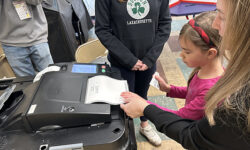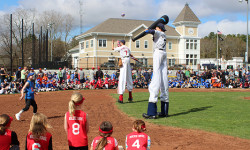Sometimes a squiggly line is more than a squiggly line; sometimes it can be whatever you want it to be.
That’s the lesson students at the Hanlon Elementary School learned during a recent event led by Hanlon first-graders in celebration of International Creativity Month.
Inspired by the Antoinette Portis book, “Not A Box,” the “Celebrating Creativity” project involved presenting Hanlon students with a single sheet of paper on which various shapes were printed. These could be anything from the aforementioned squiggly line to a loop or a right angle. If the pupils preferred, they could request a blank sheet of paper. Teachers then encouraged students to use their imaginations — and a wide variety of art supplies — to make the shape or the blank space into something more.
Portis’ book tells a simple story about how it takes only imagination and creativity to turn a box into whatever you want, such as a race car, rocket, or robot. Each classroom received a copy of the book, and teachers used it to help inspire students.
According to Principal Sarah Cronin, first grade teacher Valerie Sharpe approached her with the idea as a possibility for Hanlon’s January All School Meeting. Inspired by recent WPS professional development in science and in social/emotional learning, she said, “As teachers, we need to be thinking about developing a future generation to solve the problems of tomorrow. It’s not about whether or not kids can remember a set of facts, it’s about children being able to think independently; to be able do things without the teacher guiding them through the steps.”
Students, teachers, and staff were introduced to the activity during the All-School Meeting on January 11. They watched a video featuring the first graders answering questions about what it means to be creative, to think outside the box, and what to do if they get stuck on their projects.
“If you make a little mistake on anything, you can turn it into something else. It didn’t need to be exactly the thing you thought,” said one of the first graders. “You can change it and you can turn it into a beautiful thing.”
Others offered advice like “if it doesn’t look right, turn it sideways” and “take a deep breath and try again.”
Music teacher Katelyn Pickering created a playlist for the classrooms to help spark the children’s creativity. Art teacher Carla Goodwin created an instructional video that demonstrated a variety of techniques, including paper sculpture and collage to make designs pop off the page.
Once completed, students signed their works of art, which the teachers then mounted on colorful paper and put on display throughout the school building.
Cronin emphasized that this project was about much more than making pretty pictures. The whole process underpinned a vital goal. Creativity, she said, is directly linked to problem-solving.
“As we prepare students to solve the problems of the world they will inherit as adults, we know that creativity is undisputed as one of the most important traits of a successful problem-solver,” said
Science Coordinator Kate Doyle.“So much time is spent in schools preparing students academically,” she explained, that creativity can fall by the wayside. The goal of focusing on it in January was to encourage the free thinking that is crucial to devising new ways of approaching problems and achieving goals. When given the opportunity to do so, Cronin said students can come up with solutions that adults haven’t even considered.
“As educators, we’re preparing students to do jobs that don’t even exist right now,” she said. “Employers may be looking for some specific skills, but what they’ll really need are problem-solvers. They’ll want people with the emotional quotient to handle problems they’ve never seen before.”
While this is the first year for this specific project, it also falls under Hanlon’s ongoing One School/One Story program. Each year, copies of a single picture book are given to every classroom to serve as an inspiration for a greater purpose. Previous books related to topics around kindness and Black History Month. In January, the purpose was creativity.























